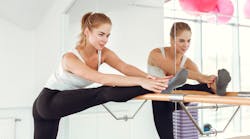We all know the aches, stress, and occasional pain that the dental hygienist encounters throughout her career. Dental professionals face the occupational hazard of being more susceptible to musculoskeletal disorders. Fortunately there are several options to prevent or relieve work-related discomfort. There are a variety of physical activities that a dental hygienist can do to stay proactive against work-related pain. The following are my top three fitness routines for the dental hygienist.
Yoga
First, let’s talk about yoga! Yoga is essential for the dental hygienist because it allows relaxation for both the mind and body. The role of a dental hygienist demands mental and physical energy. Yoga can provide many physical health benefits through relaxation techniques. These benefits can notably reduce chronic pain, such as lower back pain, arthritis, headaches and carpal tunnel syndrome.1
There are various types of yoga classes available, from beginners to intermediate. This allows anyone to be able to participate and benefit from the healing practices. There are many different options for yoga. It can be done in your home or in a class setting. There are also options for outdoor yoga, which provide even more health benefits. Check out your local community centers, as there are often free yoga classes that are available. There are numerous yoga apps as well. Download an app such as Daily Yoga then you can practice at home, during lunch, or in between patients.
Barre
Second, get your butt to a barre class! Barre classes are low-impact, ballet-inspired fitness workouts that emphasize overall conditioning of your body. These classes will target core muscles that are important to the dental hygienist. Typically a barre class will focus on exercises that strengthen your core, arms, glutes, back, and legs.
Barre is highly recommended, as you have the ability to burn calories while building strength and improving balance. Barre will enhance your posture and strengthen your core, therefore improving your ergonomics at work! Barre classes are becoming very popular and offer levels from beginner to expert depending on your comfort level.
Spin
Last but not least, get to a spin class! Indoor cycling benefits your overall health, and as healthcare providers it’s important to practice what we preach.
A spin class is a high-intensity indoor cycling workout on a stationary bike with varying body positioning, resistance, and speed. Indoor cycling will increase muscle definition in your legs and core. Again, strengthening your core is essential and improves your ability to hold your body upright.
Indoor cycling is considered low-impact, which suggests no risk for injury. The bike is stationary, so the exercise won’t jar the hip or put pressure on knee or ankle joints. The varying positions of a cycle class will support your back, and the pitched-forward position provides toning and strengthening to muscles along your spine.
Indoor cycling most often is in a class format, but with new at-home equipment such as the Peloton, even this type of fitness can be done in the comfort of your home. The group setting of spin classes is extremely motivational. It allows individuals to push themselves and reach fitness goals every single class. So grab your dental bestie and give a spin class a try!
RELATED | FROM RDH MAGAZINE
New year, new professional fitness: Workout routines for dental professionals
New year, new professional fitness: ‘Neck pain’ or ‘pain in the neck’?
Reference
1. Benefits of Yoga. (n.d.). Retrieved from https://osteopathic.org/what-is-osteopathic-medicine/benefits-of-yoga/








